Top 5 OPE Dealer Frequently Asked Questions
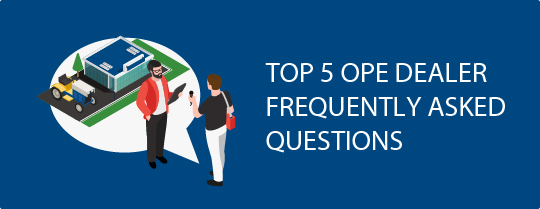
We know that as dealership owners, you’ve got a lot of things to keep track of at any given time which might leave you with a lot of burning questions about your business. That’s why, based on feedback from other OPE dealers, we put together a list of their 5 most frequently asked questions. With expert insights and advice from Sara Hey, Vice-President of Bob Clements International, we answer those questions below.
5 OPE Dealer Frequently Asked Questions:
1. How much money should I spend on marketing?
2. How much should I pay technicians?
3. What are the three numbers, by department, I should be looking at for my dealership?
4. What are my next steps after installing the software at my dealership?
5. How should I respond to the current inventory situation?
1. How much money should I spend on marketing?
Most dealers fall into one of two categories: the 3% category or the 5% category. In terms of expenditure, you are spending either 3% or 5% of ALL the revenue you generate towards marketing.
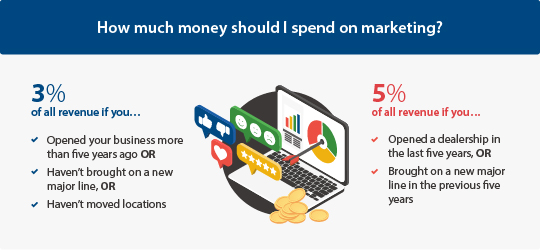
If you opened your dealership in the last five years or brought on a new major line in the previous five years, you will be in the 5% category. If you opened your business more than five years ago and haven’t brought on a new major line or moved locations in that time, you will be in the 3% category.
For example, a million-dollar dealership in the 3% category should be spending $30,000 on marketing. If it’s in the 5% category, then $50,000 should be going towards marketing. The caveat to this is that we would expect manufacturers to contribute 50% of the marketing dollars spent.
Realistically, you have $15,000 coming out of your pocket for marketing in the 3% category or $25,000 in the 5% category. How much you spend will be different depending on how the marketing dollars are allocated.
2. How much should I pay technicians?
To determine your pay rate for technicians, look at your posted labor rate. From there, you will find that you can pay an A-Level Technician 30% of your posted labor rates.
For example, if you have a $100 an hour posted labor rate, of which you can spend 30% on an A-Level Technician per hour, then you have a $30.00 per hour salary cap for an A-Level Technician. The breakdown of the rest of the $100 posted labor rate is as follows:
- 15% towards management costs
- 35% towards departmental costs
- 20% towards the owner’s profits
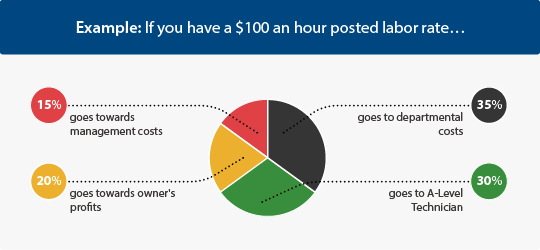
The 15% ($15.00) management costs cover the service manager, service writer, or someone else managing the service department.
The 35% ($35.00) departmental costs cover things like keeping the lights on, making sure insurance is paid, and all the other things that come with having a Service Department open.
Then 20% ($20.00) of every labor dollar produced is the owner’s profit. As an owner, it’s expected that you keep $20 for every $100 produced in your Service Department as profit.
What if you can’t get technicians in your area with your salary cap?
Raise your labor rate.
Before raising it, find out what a sustainable labor rate is in your area. This can be done by calling the local car dealerships and asking them what their labor rates are.
A few years ago, Ford spent $20 million to figure out what the labor rate needed to be to have technicians in every single local community. So, unless you want to spend $20 million out of your pocket, give the closest Ford dealership a call. Once you know what the Ford dealership’s labor rate is, you can adjust it for your dealership type.
For most outdoor power equipment dealers and compact tractor dealers, a sustainable labor rate would be about 10% less than the Ford dealership. They’ve already done the math for you, so go ahead and lean into that.
3. What are the three numbers, by department, I need to be looking at for my dealership?
Here are the numbers that I would be looking at consistently in Service, Parts, and Sales.
Service:
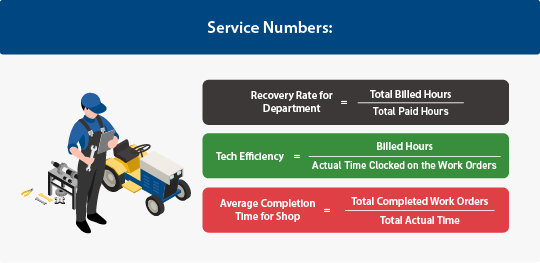
- Recovery Rate for Department = Total Billed Hours / Total Paid Hours
Your service department’s recovery rate tells you what percentage of time you are buying each day compared to the amount of time you are selling each day. This number tells you two critical things. First, it gives you a cohesive view of the amount of work coming into the service department. Second, your recovery rate allows you to see if you are going to need another technician soon.
- Tech Efficiency = Billed Hours / Actual Time Clocked on the Work Order
Technician efficiency tells you how quickly a job is completed versus what the service department was able to charge for it. Tech efficiency should be monitored daily by the service manager or service writer.
- Average Completion Time for Shop = Total Completed Work Orders / Total Actual Time
The average completion time for the shop tells your service manager how far ahead the department is booked.
Parts:
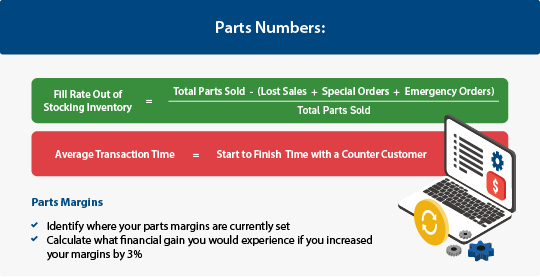
- Fill Rate Out of Stocking Inventory = Total Parts Sold – Lost Sales, Special Orders, and Emergency Orders / Total Parts Sold
- Goal: 85% to 90%
Your fill rate out of stocking inventory tells you what percentage of the time you can fulfil the customers’ order the first time they come in for a specific part.
- Average Transaction Time = Start-to-Finish Time with a Counter Customer
The average transaction time is a measurement of how long it takes a customer to walk up to the parts counter, get their part, pay, and be on their way.
- Parts Margins
Take a moment to look at your current parts margins and do two things: identify where your parts margins are currently set and calculate what financial gain you would experience if you were to increase your margins by 3%.
Sales:
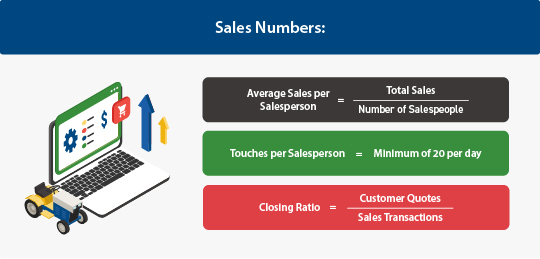
- Average Sales per Salesperson = Total Sales / Number of Salespeople
Hitting projected sales goals is critical to the health of the dealership. Many dealers struggle to maintain profit to cover dealership expenses without reaching the anticipated levels. Knowing the average number of sales per salesperson will help you and your team set daily activity goals.
- Touches per Salesperson = Minimum of 20 per Day
A customer touch is any interaction that your salesperson has with a customer. This could be a phone call, an email, a text, a minivan full of people who ask to use the bathroom, or even a walk-in customer.
- Closing Ratio = Customer Quotes / Sales Transactions
Looking at the closing ratio in sales, our goal is that salespeople have a closing ratio of around 40%.
4. What are my next steps after I install the software at my dealership?
First, don’t try to change everything at once! Determine where, specifically, you want to start with the change in your dealership. Although you will eventually be trained on all aspects of the dealership software, you ought to dive head-first into one part and master it!
For example, most dealers we work with will pick parts or service to start. If you and your team understand the Point of Sale (POS), then you might decide to become a service module pro. Commit the time to the training and implement the basics, like your techs clocking in and out of every work order.
Then, focus on making sure you understand how to pull your KPIs or the numbers that tell you about the health of your dealership. Next, go through training to make sure you’re maximizing the customer quote tools. Finally, look and ask what and how you can create standard job rates (or flat rates) through the software.
Don’t try to do it all at once. You will find that as you familiarize yourself and learn to maximize your software, one part builds onto the next!
5. How should I respond to the current inventory situation?
There is nothing tenser right now in the industry than conversations around inventory. It’s no secret that there’s not enough of it, so what is a dealer to do?
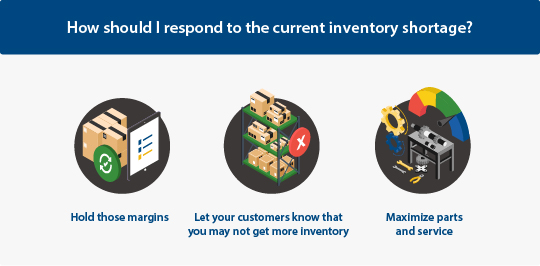
Hold those margins
Hold the margins, but also raise the margins on your units. Most of the dealers we are working with are adding an extra 3-5% margin onto their units in stock. They understand that the additional margin is needed to get them through the year.
Let your customers know that you may not get more inventory
One of the most powerful things you can do is be honest with your customers about the current situation. I If they are thinking about getting a unit, then let them know that now is the time to decide. Honesty will go a long way in keeping your most loyal customers happy.
Maximize parts and service
For most dealerships, basic wear parts are back! Yes, it’s okay; we can all cheer collectively. Having a conversation with customers about doing annual or bi-annual maintenance on their units to keep them in peak performance is more critical than ever.
This not only keeps them up and running but allows you to have fantastic revenue. As an additional note, if you have salespeople who don’t have enough to sell, have them reach out to customers about parts and service!
There is always room for improvement!
Whether you’re a seasoned OPE dealership owner or just getting started, there are always more ways you can improve your dealership’s efficiency and profitability. We hope that these answers have helped shed some light on some of the most pertinent questions that are currently on the minds of OPE dealers.
Author Bio:

Sara Hey, Vice-President, Bob Clements International
Sara’s journey working with dealerships started when she was young by providing child labor packing VHS training tapes for dealers across the country. In college, she studied psychology, which has been a huge benefit working in her family’s business as well as with family-owned dealerships over the last 10+ years. Now, Sara spends her time speaking at conferences around the world and working with both manufacturers and dealers to achieve success.

